Imperative Factors for Choice and Requisite Tax Treatment of Outgoings
VerifiedAdded on 2023/06/07
|9
|2707
|346
AI Summary
This article discusses the factors to consider while choosing the appropriate method for computation of income and the tax treatment of various outgoings. It explains the legalities and implications of revenue and capital expenditure. The article also provides relevant case laws and sections of the Income Tax Assessment Act 1997 to support the discussion.
Contribute Materials
Your contribution can guide someone’s learning journey. Share your
documents today.
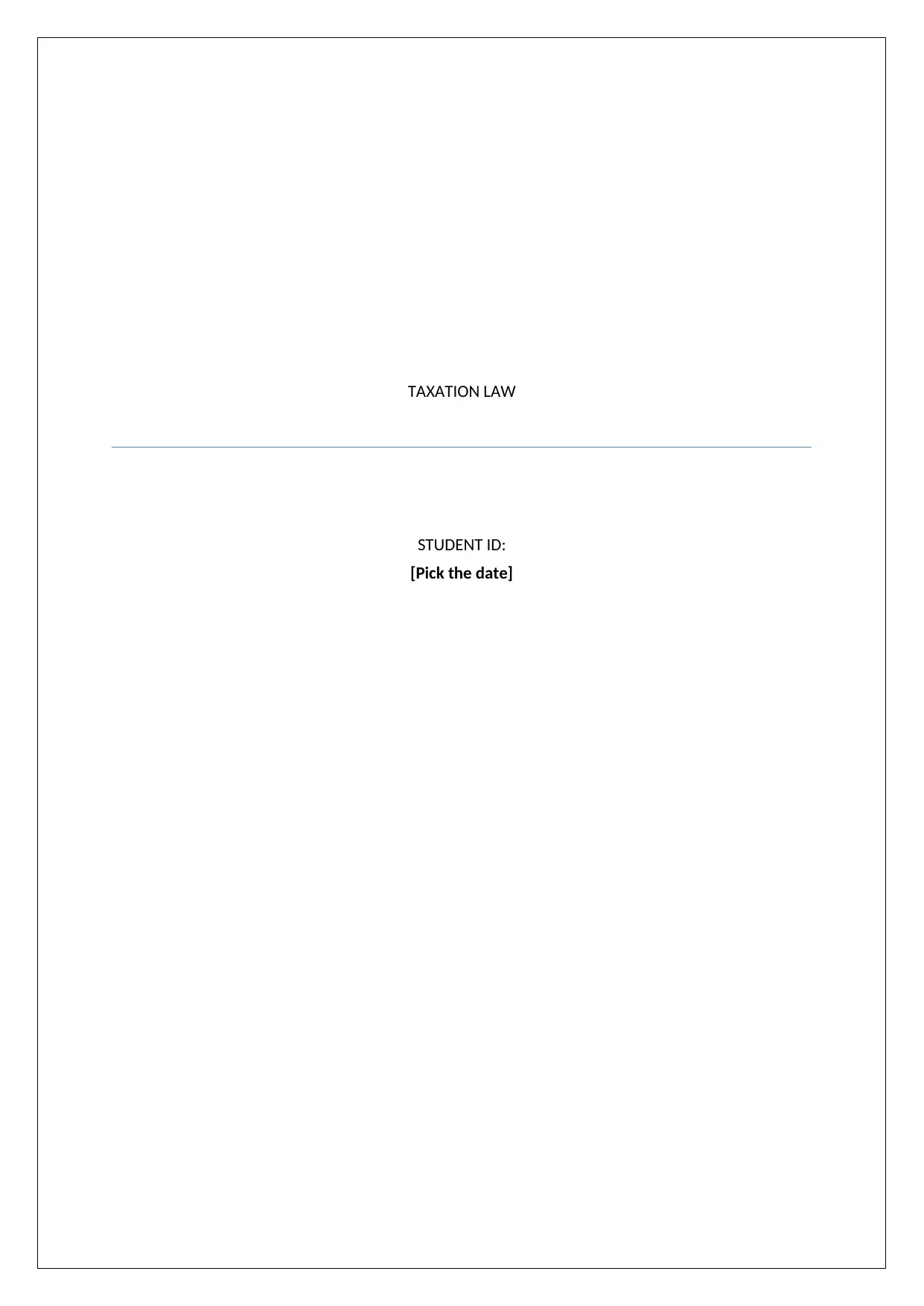
TAXATION LAW
STUDENT ID:
[Pick the date]
STUDENT ID:
[Pick the date]
Secure Best Marks with AI Grader
Need help grading? Try our AI Grader for instant feedback on your assignments.
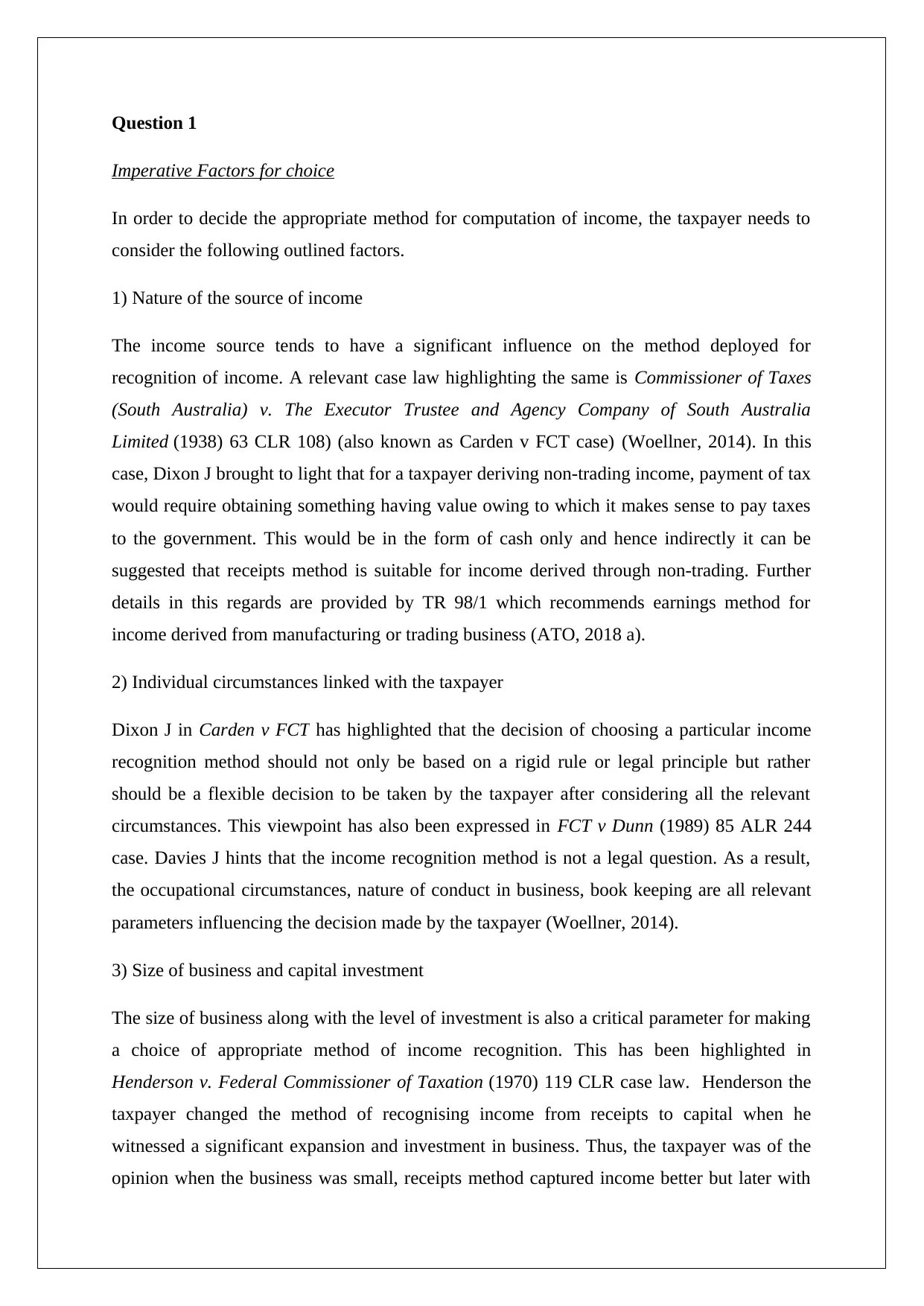
Question 1
Imperative Factors for choice
In order to decide the appropriate method for computation of income, the taxpayer needs to
consider the following outlined factors.
1) Nature of the source of income
The income source tends to have a significant influence on the method deployed for
recognition of income. A relevant case law highlighting the same is Commissioner of Taxes
(South Australia) v. The Executor Trustee and Agency Company of South Australia
Limited (1938) 63 CLR 108) (also known as Carden v FCT case) (Woellner, 2014). In this
case, Dixon J brought to light that for a taxpayer deriving non-trading income, payment of tax
would require obtaining something having value owing to which it makes sense to pay taxes
to the government. This would be in the form of cash only and hence indirectly it can be
suggested that receipts method is suitable for income derived through non-trading. Further
details in this regards are provided by TR 98/1 which recommends earnings method for
income derived from manufacturing or trading business (ATO, 2018 a).
2) Individual circumstances linked with the taxpayer
Dixon J in Carden v FCT has highlighted that the decision of choosing a particular income
recognition method should not only be based on a rigid rule or legal principle but rather
should be a flexible decision to be taken by the taxpayer after considering all the relevant
circumstances. This viewpoint has also been expressed in FCT v Dunn (1989) 85 ALR 244
case. Davies J hints that the income recognition method is not a legal question. As a result,
the occupational circumstances, nature of conduct in business, book keeping are all relevant
parameters influencing the decision made by the taxpayer (Woellner, 2014).
3) Size of business and capital investment
The size of business along with the level of investment is also a critical parameter for making
a choice of appropriate method of income recognition. This has been highlighted in
Henderson v. Federal Commissioner of Taxation (1970) 119 CLR case law. Henderson the
taxpayer changed the method of recognising income from receipts to capital when he
witnessed a significant expansion and investment in business. Thus, the taxpayer was of the
opinion when the business was small, receipts method captured income better but later with
Imperative Factors for choice
In order to decide the appropriate method for computation of income, the taxpayer needs to
consider the following outlined factors.
1) Nature of the source of income
The income source tends to have a significant influence on the method deployed for
recognition of income. A relevant case law highlighting the same is Commissioner of Taxes
(South Australia) v. The Executor Trustee and Agency Company of South Australia
Limited (1938) 63 CLR 108) (also known as Carden v FCT case) (Woellner, 2014). In this
case, Dixon J brought to light that for a taxpayer deriving non-trading income, payment of tax
would require obtaining something having value owing to which it makes sense to pay taxes
to the government. This would be in the form of cash only and hence indirectly it can be
suggested that receipts method is suitable for income derived through non-trading. Further
details in this regards are provided by TR 98/1 which recommends earnings method for
income derived from manufacturing or trading business (ATO, 2018 a).
2) Individual circumstances linked with the taxpayer
Dixon J in Carden v FCT has highlighted that the decision of choosing a particular income
recognition method should not only be based on a rigid rule or legal principle but rather
should be a flexible decision to be taken by the taxpayer after considering all the relevant
circumstances. This viewpoint has also been expressed in FCT v Dunn (1989) 85 ALR 244
case. Davies J hints that the income recognition method is not a legal question. As a result,
the occupational circumstances, nature of conduct in business, book keeping are all relevant
parameters influencing the decision made by the taxpayer (Woellner, 2014).
3) Size of business and capital investment
The size of business along with the level of investment is also a critical parameter for making
a choice of appropriate method of income recognition. This has been highlighted in
Henderson v. Federal Commissioner of Taxation (1970) 119 CLR case law. Henderson the
taxpayer changed the method of recognising income from receipts to capital when he
witnessed a significant expansion and investment in business. Thus, the taxpayer was of the
opinion when the business was small, receipts method captured income better but later with
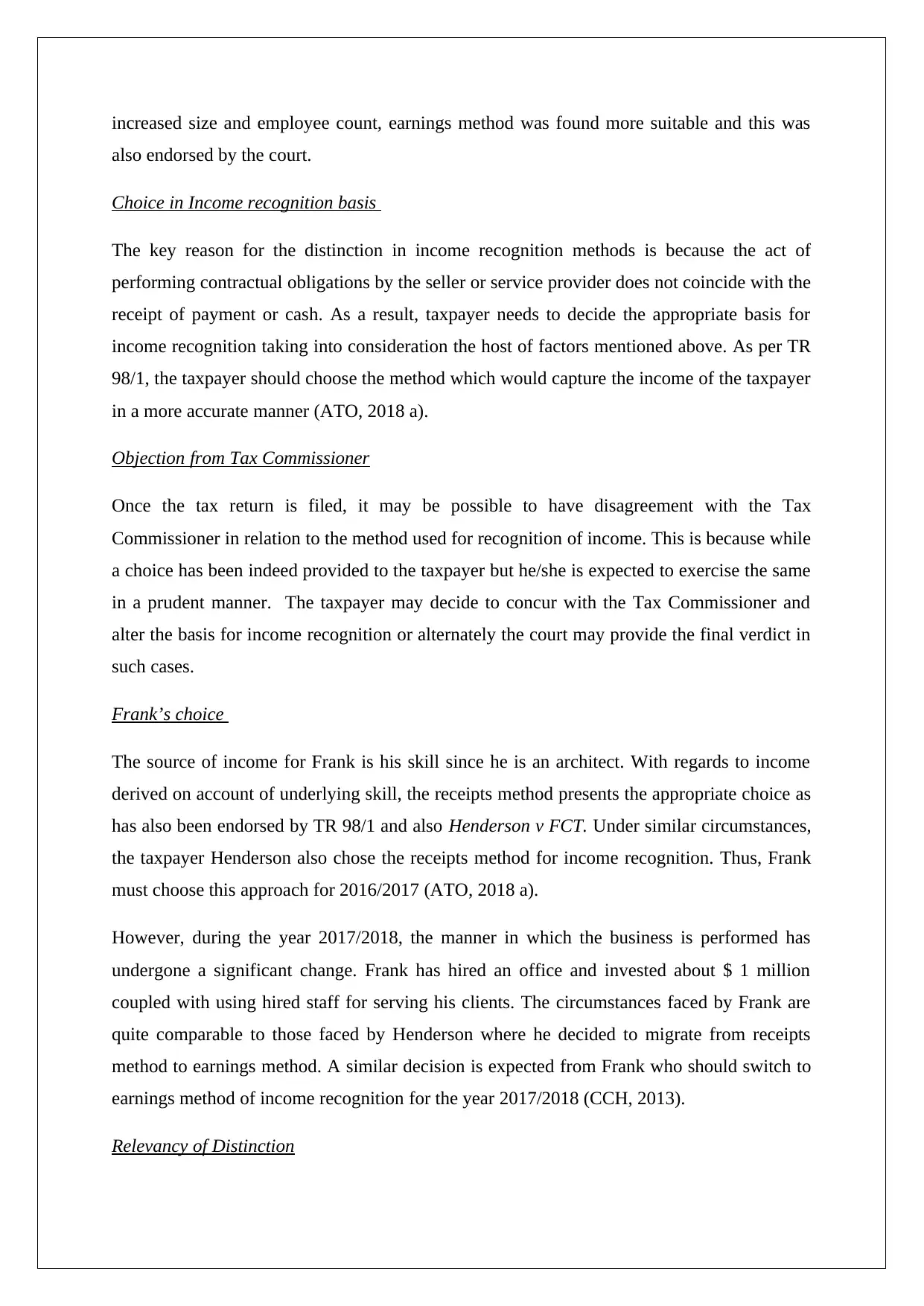
increased size and employee count, earnings method was found more suitable and this was
also endorsed by the court.
Choice in Income recognition basis
The key reason for the distinction in income recognition methods is because the act of
performing contractual obligations by the seller or service provider does not coincide with the
receipt of payment or cash. As a result, taxpayer needs to decide the appropriate basis for
income recognition taking into consideration the host of factors mentioned above. As per TR
98/1, the taxpayer should choose the method which would capture the income of the taxpayer
in a more accurate manner (ATO, 2018 a).
Objection from Tax Commissioner
Once the tax return is filed, it may be possible to have disagreement with the Tax
Commissioner in relation to the method used for recognition of income. This is because while
a choice has been indeed provided to the taxpayer but he/she is expected to exercise the same
in a prudent manner. The taxpayer may decide to concur with the Tax Commissioner and
alter the basis for income recognition or alternately the court may provide the final verdict in
such cases.
Frank’s choice
The source of income for Frank is his skill since he is an architect. With regards to income
derived on account of underlying skill, the receipts method presents the appropriate choice as
has also been endorsed by TR 98/1 and also Henderson v FCT. Under similar circumstances,
the taxpayer Henderson also chose the receipts method for income recognition. Thus, Frank
must choose this approach for 2016/2017 (ATO, 2018 a).
However, during the year 2017/2018, the manner in which the business is performed has
undergone a significant change. Frank has hired an office and invested about $ 1 million
coupled with using hired staff for serving his clients. The circumstances faced by Frank are
quite comparable to those faced by Henderson where he decided to migrate from receipts
method to earnings method. A similar decision is expected from Frank who should switch to
earnings method of income recognition for the year 2017/2018 (CCH, 2013).
Relevancy of Distinction
also endorsed by the court.
Choice in Income recognition basis
The key reason for the distinction in income recognition methods is because the act of
performing contractual obligations by the seller or service provider does not coincide with the
receipt of payment or cash. As a result, taxpayer needs to decide the appropriate basis for
income recognition taking into consideration the host of factors mentioned above. As per TR
98/1, the taxpayer should choose the method which would capture the income of the taxpayer
in a more accurate manner (ATO, 2018 a).
Objection from Tax Commissioner
Once the tax return is filed, it may be possible to have disagreement with the Tax
Commissioner in relation to the method used for recognition of income. This is because while
a choice has been indeed provided to the taxpayer but he/she is expected to exercise the same
in a prudent manner. The taxpayer may decide to concur with the Tax Commissioner and
alter the basis for income recognition or alternately the court may provide the final verdict in
such cases.
Frank’s choice
The source of income for Frank is his skill since he is an architect. With regards to income
derived on account of underlying skill, the receipts method presents the appropriate choice as
has also been endorsed by TR 98/1 and also Henderson v FCT. Under similar circumstances,
the taxpayer Henderson also chose the receipts method for income recognition. Thus, Frank
must choose this approach for 2016/2017 (ATO, 2018 a).
However, during the year 2017/2018, the manner in which the business is performed has
undergone a significant change. Frank has hired an office and invested about $ 1 million
coupled with using hired staff for serving his clients. The circumstances faced by Frank are
quite comparable to those faced by Henderson where he decided to migrate from receipts
method to earnings method. A similar decision is expected from Frank who should switch to
earnings method of income recognition for the year 2017/2018 (CCH, 2013).
Relevancy of Distinction

The key reason for the distinction in income recognition methods is because the act of
performing contractual obligations by the seller or service provider does not coincide with the
receipt of payment or cash. The tax year terminates on 30th June but the receipt of cash and
performance of contractual obligation may not lie in the same tax year. The accounting
software use can enable better cash flow monitoring and computation but the recognition is
still a subjective process as mentioned in the various case laws that have been cited in the
above discussion (Barkoczy, 2015). Thus, the distinction between these two methods
continues to be relevant even in the current era.
Question 2
The requisite tax treatment of the various outgoings that have been undertaken by the given
taxpayer (Ruby Pty Ltd) has been explained as follows.
(a) In wake of the given information, it can be concluded that the expense related to
replacement of the damaged kitchen fittings would be considered as repair in line with the
discussion in TR 97/23 (ATO, 2018 b). Through repair there has been no improvement but
rather restoration of the previous character and also expense was incurred only when actual
damage to pipe fittings was already done. Considering that the given repairs pertain to a
rental property, hence potential tax deduction may be claimed by the taxpayer in accordance
with s. 8-1 (general deduction) or s. 25-10 (CCH, 2013).
Section 8-1, ITAA 1997 provides general deduction on any outgoings or expense that have a
sufficient and direct nexus with the derivation of assessable income (Austlli, 2018 c). A
negative limb highlighted in ss.8-1(2) relates to tax deduction not being available if the
underlying expenditure is termed as capital and not revenue. Section 25-10 provides tax
deduction in context of expenses of repairs provided these pertain to the property or
depreciable asset occupying a part of this property which tends to contribute to assessable
income generation. As per ss.25-10(3), the only restriction is that the expenditure should not
be termed as capital.
In context of kitchen fittings, it is essential to highlight that majority of the components are in
the form of fixtures that are permanent in nature. This includes plumbing, cupboard, sink,
built-in stove and owing to these being part of the property itself, hence no depreciation is
available on these assets as explained in IT 242 (ATO, 1964). Also, TR 97/23 underlines that
since the kitchen fittings are part of the property, hence any repairs on these would form part
performing contractual obligations by the seller or service provider does not coincide with the
receipt of payment or cash. The tax year terminates on 30th June but the receipt of cash and
performance of contractual obligation may not lie in the same tax year. The accounting
software use can enable better cash flow monitoring and computation but the recognition is
still a subjective process as mentioned in the various case laws that have been cited in the
above discussion (Barkoczy, 2015). Thus, the distinction between these two methods
continues to be relevant even in the current era.
Question 2
The requisite tax treatment of the various outgoings that have been undertaken by the given
taxpayer (Ruby Pty Ltd) has been explained as follows.
(a) In wake of the given information, it can be concluded that the expense related to
replacement of the damaged kitchen fittings would be considered as repair in line with the
discussion in TR 97/23 (ATO, 2018 b). Through repair there has been no improvement but
rather restoration of the previous character and also expense was incurred only when actual
damage to pipe fittings was already done. Considering that the given repairs pertain to a
rental property, hence potential tax deduction may be claimed by the taxpayer in accordance
with s. 8-1 (general deduction) or s. 25-10 (CCH, 2013).
Section 8-1, ITAA 1997 provides general deduction on any outgoings or expense that have a
sufficient and direct nexus with the derivation of assessable income (Austlli, 2018 c). A
negative limb highlighted in ss.8-1(2) relates to tax deduction not being available if the
underlying expenditure is termed as capital and not revenue. Section 25-10 provides tax
deduction in context of expenses of repairs provided these pertain to the property or
depreciable asset occupying a part of this property which tends to contribute to assessable
income generation. As per ss.25-10(3), the only restriction is that the expenditure should not
be termed as capital.
In context of kitchen fittings, it is essential to highlight that majority of the components are in
the form of fixtures that are permanent in nature. This includes plumbing, cupboard, sink,
built-in stove and owing to these being part of the property itself, hence no depreciation is
available on these assets as explained in IT 242 (ATO, 1964). Also, TR 97/23 underlines that
since the kitchen fittings are part of the property, hence any repairs on these would form part
Secure Best Marks with AI Grader
Need help grading? Try our AI Grader for instant feedback on your assignments.
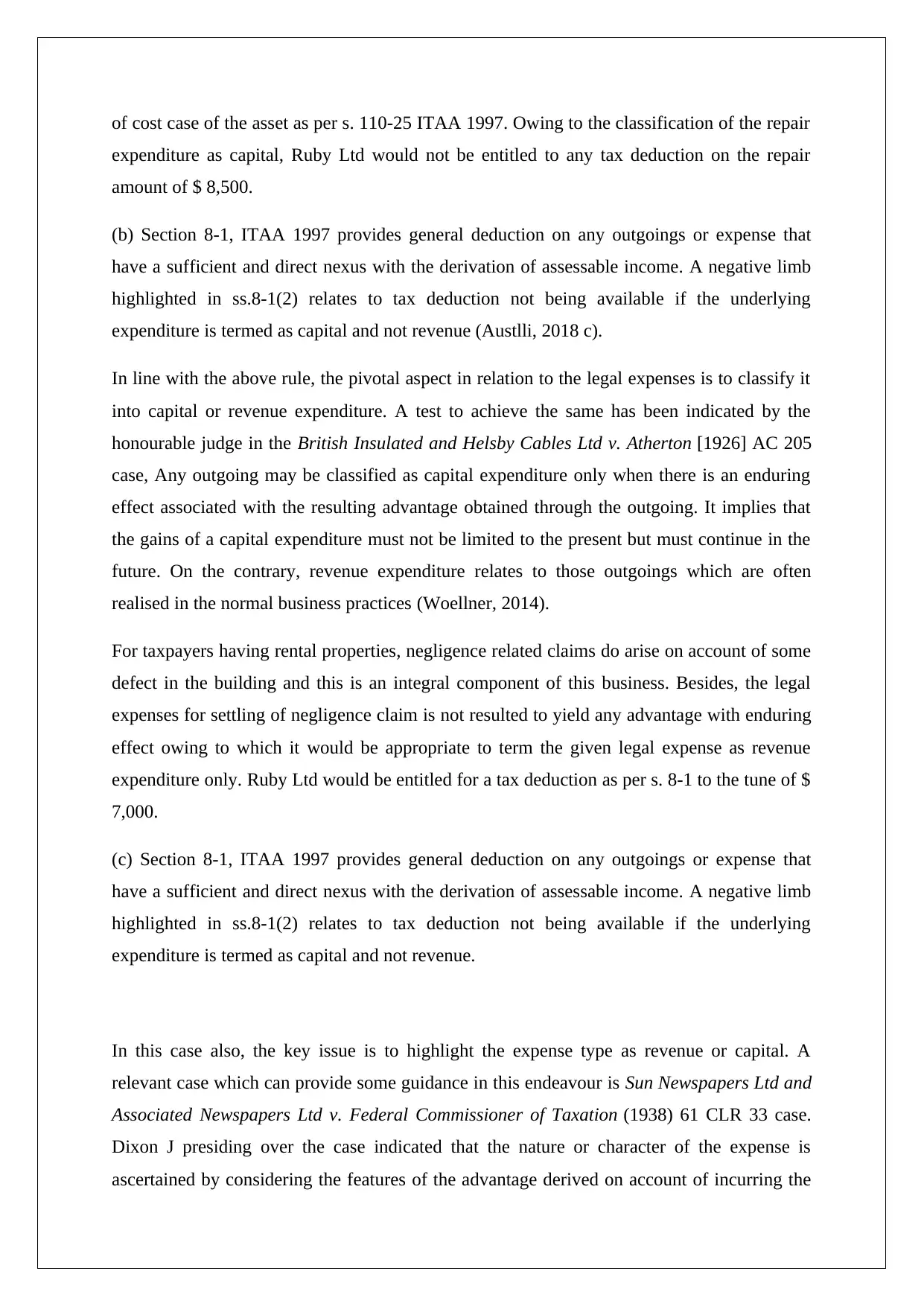
of cost case of the asset as per s. 110-25 ITAA 1997. Owing to the classification of the repair
expenditure as capital, Ruby Ltd would not be entitled to any tax deduction on the repair
amount of $ 8,500.
(b) Section 8-1, ITAA 1997 provides general deduction on any outgoings or expense that
have a sufficient and direct nexus with the derivation of assessable income. A negative limb
highlighted in ss.8-1(2) relates to tax deduction not being available if the underlying
expenditure is termed as capital and not revenue (Austlli, 2018 c).
In line with the above rule, the pivotal aspect in relation to the legal expenses is to classify it
into capital or revenue expenditure. A test to achieve the same has been indicated by the
honourable judge in the British Insulated and Helsby Cables Ltd v. Atherton [1926] AC 205
case, Any outgoing may be classified as capital expenditure only when there is an enduring
effect associated with the resulting advantage obtained through the outgoing. It implies that
the gains of a capital expenditure must not be limited to the present but must continue in the
future. On the contrary, revenue expenditure relates to those outgoings which are often
realised in the normal business practices (Woellner, 2014).
For taxpayers having rental properties, negligence related claims do arise on account of some
defect in the building and this is an integral component of this business. Besides, the legal
expenses for settling of negligence claim is not resulted to yield any advantage with enduring
effect owing to which it would be appropriate to term the given legal expense as revenue
expenditure only. Ruby Ltd would be entitled for a tax deduction as per s. 8-1 to the tune of $
7,000.
(c) Section 8-1, ITAA 1997 provides general deduction on any outgoings or expense that
have a sufficient and direct nexus with the derivation of assessable income. A negative limb
highlighted in ss.8-1(2) relates to tax deduction not being available if the underlying
expenditure is termed as capital and not revenue.
In this case also, the key issue is to highlight the expense type as revenue or capital. A
relevant case which can provide some guidance in this endeavour is Sun Newspapers Ltd and
Associated Newspapers Ltd v. Federal Commissioner of Taxation (1938) 61 CLR 33 case.
Dixon J presiding over the case indicated that the nature or character of the expense is
ascertained by considering the features of the advantage derived on account of incurring the
expenditure as capital, Ruby Ltd would not be entitled to any tax deduction on the repair
amount of $ 8,500.
(b) Section 8-1, ITAA 1997 provides general deduction on any outgoings or expense that
have a sufficient and direct nexus with the derivation of assessable income. A negative limb
highlighted in ss.8-1(2) relates to tax deduction not being available if the underlying
expenditure is termed as capital and not revenue (Austlli, 2018 c).
In line with the above rule, the pivotal aspect in relation to the legal expenses is to classify it
into capital or revenue expenditure. A test to achieve the same has been indicated by the
honourable judge in the British Insulated and Helsby Cables Ltd v. Atherton [1926] AC 205
case, Any outgoing may be classified as capital expenditure only when there is an enduring
effect associated with the resulting advantage obtained through the outgoing. It implies that
the gains of a capital expenditure must not be limited to the present but must continue in the
future. On the contrary, revenue expenditure relates to those outgoings which are often
realised in the normal business practices (Woellner, 2014).
For taxpayers having rental properties, negligence related claims do arise on account of some
defect in the building and this is an integral component of this business. Besides, the legal
expenses for settling of negligence claim is not resulted to yield any advantage with enduring
effect owing to which it would be appropriate to term the given legal expense as revenue
expenditure only. Ruby Ltd would be entitled for a tax deduction as per s. 8-1 to the tune of $
7,000.
(c) Section 8-1, ITAA 1997 provides general deduction on any outgoings or expense that
have a sufficient and direct nexus with the derivation of assessable income. A negative limb
highlighted in ss.8-1(2) relates to tax deduction not being available if the underlying
expenditure is termed as capital and not revenue.
In this case also, the key issue is to highlight the expense type as revenue or capital. A
relevant case which can provide some guidance in this endeavour is Sun Newspapers Ltd and
Associated Newspapers Ltd v. Federal Commissioner of Taxation (1938) 61 CLR 33 case.
Dixon J presiding over the case indicated that the nature or character of the expense is
ascertained by considering the features of the advantage derived on account of incurring the
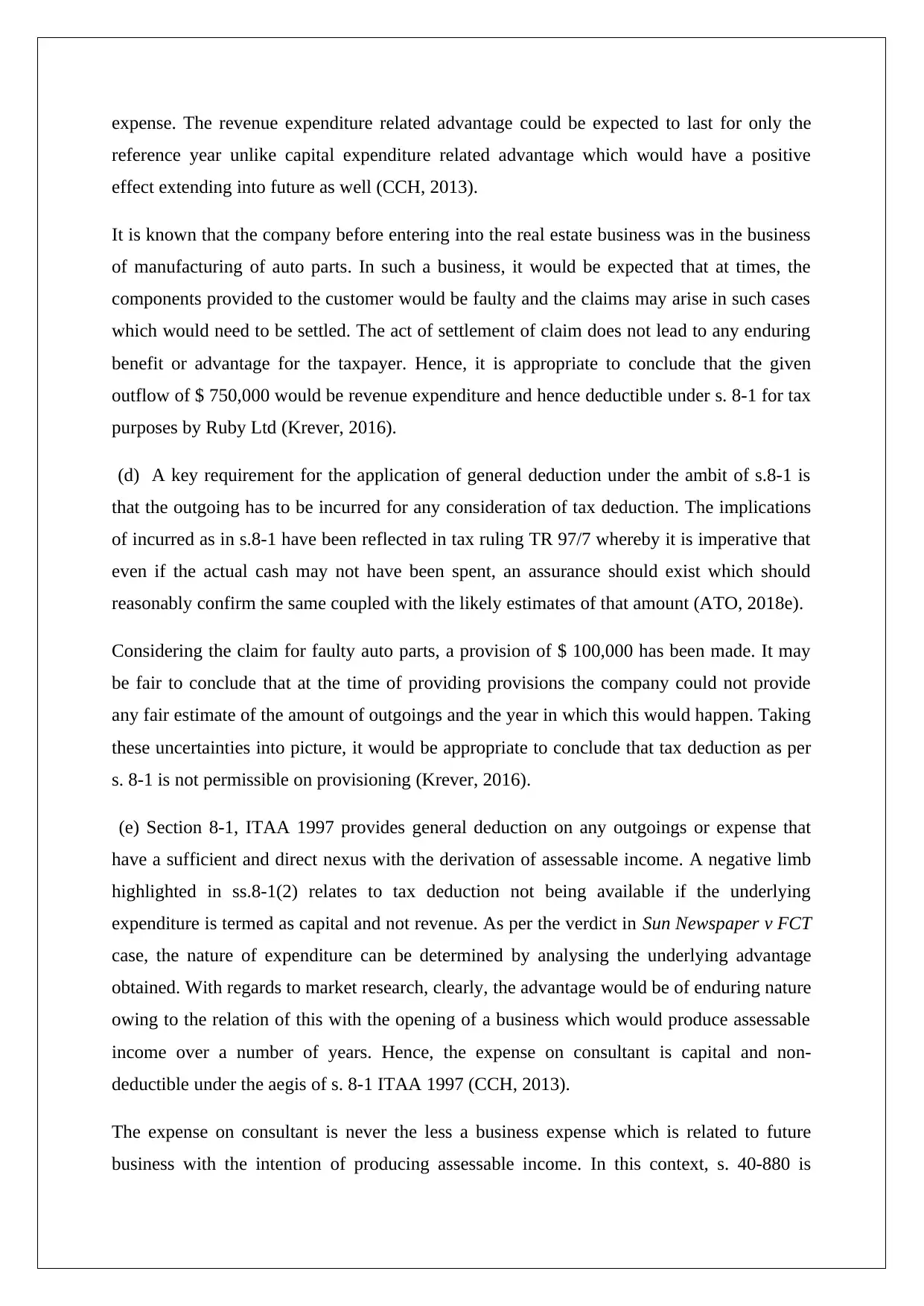
expense. The revenue expenditure related advantage could be expected to last for only the
reference year unlike capital expenditure related advantage which would have a positive
effect extending into future as well (CCH, 2013).
It is known that the company before entering into the real estate business was in the business
of manufacturing of auto parts. In such a business, it would be expected that at times, the
components provided to the customer would be faulty and the claims may arise in such cases
which would need to be settled. The act of settlement of claim does not lead to any enduring
benefit or advantage for the taxpayer. Hence, it is appropriate to conclude that the given
outflow of $ 750,000 would be revenue expenditure and hence deductible under s. 8-1 for tax
purposes by Ruby Ltd (Krever, 2016).
(d) A key requirement for the application of general deduction under the ambit of s.8-1 is
that the outgoing has to be incurred for any consideration of tax deduction. The implications
of incurred as in s.8-1 have been reflected in tax ruling TR 97/7 whereby it is imperative that
even if the actual cash may not have been spent, an assurance should exist which should
reasonably confirm the same coupled with the likely estimates of that amount (ATO, 2018e).
Considering the claim for faulty auto parts, a provision of $ 100,000 has been made. It may
be fair to conclude that at the time of providing provisions the company could not provide
any fair estimate of the amount of outgoings and the year in which this would happen. Taking
these uncertainties into picture, it would be appropriate to conclude that tax deduction as per
s. 8-1 is not permissible on provisioning (Krever, 2016).
(e) Section 8-1, ITAA 1997 provides general deduction on any outgoings or expense that
have a sufficient and direct nexus with the derivation of assessable income. A negative limb
highlighted in ss.8-1(2) relates to tax deduction not being available if the underlying
expenditure is termed as capital and not revenue. As per the verdict in Sun Newspaper v FCT
case, the nature of expenditure can be determined by analysing the underlying advantage
obtained. With regards to market research, clearly, the advantage would be of enduring nature
owing to the relation of this with the opening of a business which would produce assessable
income over a number of years. Hence, the expense on consultant is capital and non-
deductible under the aegis of s. 8-1 ITAA 1997 (CCH, 2013).
The expense on consultant is never the less a business expense which is related to future
business with the intention of producing assessable income. In this context, s. 40-880 is
reference year unlike capital expenditure related advantage which would have a positive
effect extending into future as well (CCH, 2013).
It is known that the company before entering into the real estate business was in the business
of manufacturing of auto parts. In such a business, it would be expected that at times, the
components provided to the customer would be faulty and the claims may arise in such cases
which would need to be settled. The act of settlement of claim does not lead to any enduring
benefit or advantage for the taxpayer. Hence, it is appropriate to conclude that the given
outflow of $ 750,000 would be revenue expenditure and hence deductible under s. 8-1 for tax
purposes by Ruby Ltd (Krever, 2016).
(d) A key requirement for the application of general deduction under the ambit of s.8-1 is
that the outgoing has to be incurred for any consideration of tax deduction. The implications
of incurred as in s.8-1 have been reflected in tax ruling TR 97/7 whereby it is imperative that
even if the actual cash may not have been spent, an assurance should exist which should
reasonably confirm the same coupled with the likely estimates of that amount (ATO, 2018e).
Considering the claim for faulty auto parts, a provision of $ 100,000 has been made. It may
be fair to conclude that at the time of providing provisions the company could not provide
any fair estimate of the amount of outgoings and the year in which this would happen. Taking
these uncertainties into picture, it would be appropriate to conclude that tax deduction as per
s. 8-1 is not permissible on provisioning (Krever, 2016).
(e) Section 8-1, ITAA 1997 provides general deduction on any outgoings or expense that
have a sufficient and direct nexus with the derivation of assessable income. A negative limb
highlighted in ss.8-1(2) relates to tax deduction not being available if the underlying
expenditure is termed as capital and not revenue. As per the verdict in Sun Newspaper v FCT
case, the nature of expenditure can be determined by analysing the underlying advantage
obtained. With regards to market research, clearly, the advantage would be of enduring nature
owing to the relation of this with the opening of a business which would produce assessable
income over a number of years. Hence, the expense on consultant is capital and non-
deductible under the aegis of s. 8-1 ITAA 1997 (CCH, 2013).
The expense on consultant is never the less a business expense which is related to future
business with the intention of producing assessable income. In this context, s. 40-880 is
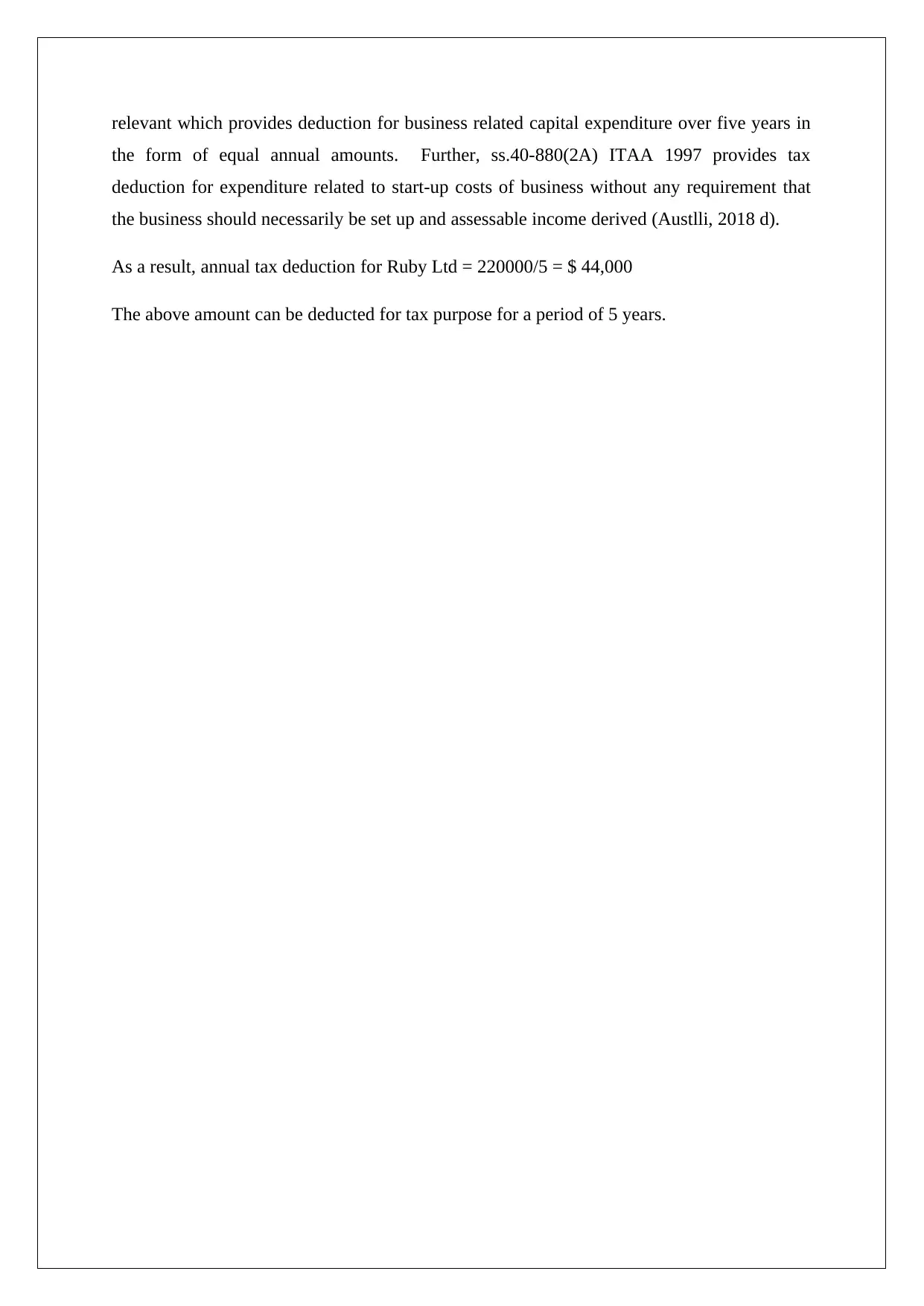
relevant which provides deduction for business related capital expenditure over five years in
the form of equal annual amounts. Further, ss.40-880(2A) ITAA 1997 provides tax
deduction for expenditure related to start-up costs of business without any requirement that
the business should necessarily be set up and assessable income derived (Austlli, 2018 d).
As a result, annual tax deduction for Ruby Ltd = 220000/5 = $ 44,000
The above amount can be deducted for tax purpose for a period of 5 years.
the form of equal annual amounts. Further, ss.40-880(2A) ITAA 1997 provides tax
deduction for expenditure related to start-up costs of business without any requirement that
the business should necessarily be set up and assessable income derived (Austlli, 2018 d).
As a result, annual tax deduction for Ruby Ltd = 220000/5 = $ 44,000
The above amount can be deducted for tax purpose for a period of 5 years.
Paraphrase This Document
Need a fresh take? Get an instant paraphrase of this document with our AI Paraphraser
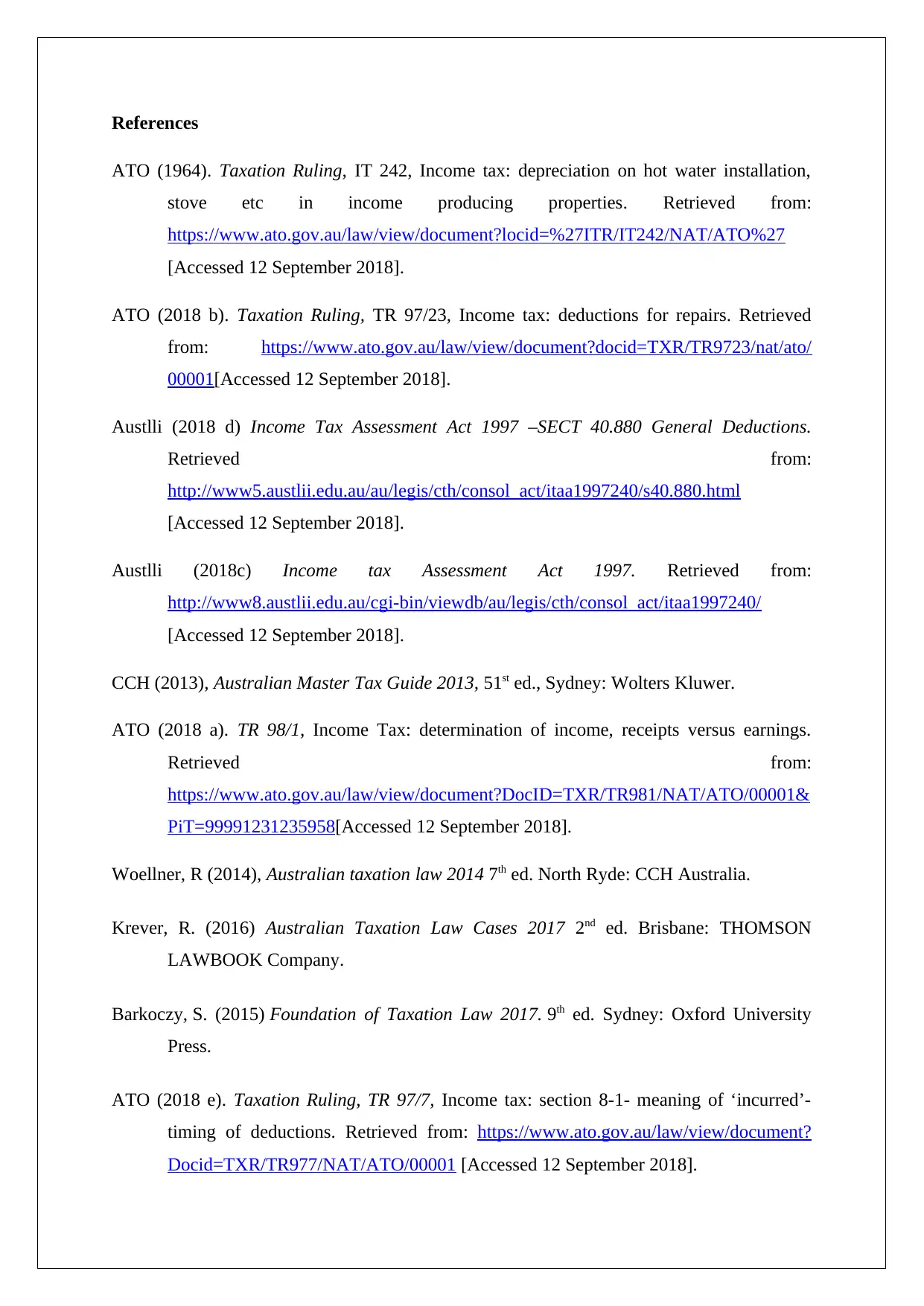
References
ATO (1964). Taxation Ruling, IT 242, Income tax: depreciation on hot water installation,
stove etc in income producing properties. Retrieved from:
https://www.ato.gov.au/law/view/document?locid=%27ITR/IT242/NAT/ATO%27
[Accessed 12 September 2018].
ATO (2018 b). Taxation Ruling, TR 97/23, Income tax: deductions for repairs. Retrieved
from: https://www.ato.gov.au/law/view/document?docid=TXR/TR9723/nat/ato/
00001[Accessed 12 September 2018].
Austlli (2018 d) Income Tax Assessment Act 1997 –SECT 40.880 General Deductions.
Retrieved from:
http://www5.austlii.edu.au/au/legis/cth/consol_act/itaa1997240/s40.880.html
[Accessed 12 September 2018].
Austlli (2018c) Income tax Assessment Act 1997. Retrieved from:
http://www8.austlii.edu.au/cgi-bin/viewdb/au/legis/cth/consol_act/itaa1997240/
[Accessed 12 September 2018].
CCH (2013), Australian Master Tax Guide 2013, 51st ed., Sydney: Wolters Kluwer.
ATO (2018 a). TR 98/1, Income Tax: determination of income, receipts versus earnings.
Retrieved from:
https://www.ato.gov.au/law/view/document?DocID=TXR/TR981/NAT/ATO/00001&
PiT=99991231235958[Accessed 12 September 2018].
Woellner, R (2014), Australian taxation law 2014 7th ed. North Ryde: CCH Australia.
Krever, R. (2016) Australian Taxation Law Cases 2017 2nd ed. Brisbane: THOMSON
LAWBOOK Company.
Barkoczy, S. (2015) Foundation of Taxation Law 2017. 9th ed. Sydney: Oxford University
Press.
ATO (2018 e). Taxation Ruling, TR 97/7, Income tax: section 8-1- meaning of ‘incurred’-
timing of deductions. Retrieved from: https://www.ato.gov.au/law/view/document?
Docid=TXR/TR977/NAT/ATO/00001 [Accessed 12 September 2018].
ATO (1964). Taxation Ruling, IT 242, Income tax: depreciation on hot water installation,
stove etc in income producing properties. Retrieved from:
https://www.ato.gov.au/law/view/document?locid=%27ITR/IT242/NAT/ATO%27
[Accessed 12 September 2018].
ATO (2018 b). Taxation Ruling, TR 97/23, Income tax: deductions for repairs. Retrieved
from: https://www.ato.gov.au/law/view/document?docid=TXR/TR9723/nat/ato/
00001[Accessed 12 September 2018].
Austlli (2018 d) Income Tax Assessment Act 1997 –SECT 40.880 General Deductions.
Retrieved from:
http://www5.austlii.edu.au/au/legis/cth/consol_act/itaa1997240/s40.880.html
[Accessed 12 September 2018].
Austlli (2018c) Income tax Assessment Act 1997. Retrieved from:
http://www8.austlii.edu.au/cgi-bin/viewdb/au/legis/cth/consol_act/itaa1997240/
[Accessed 12 September 2018].
CCH (2013), Australian Master Tax Guide 2013, 51st ed., Sydney: Wolters Kluwer.
ATO (2018 a). TR 98/1, Income Tax: determination of income, receipts versus earnings.
Retrieved from:
https://www.ato.gov.au/law/view/document?DocID=TXR/TR981/NAT/ATO/00001&
PiT=99991231235958[Accessed 12 September 2018].
Woellner, R (2014), Australian taxation law 2014 7th ed. North Ryde: CCH Australia.
Krever, R. (2016) Australian Taxation Law Cases 2017 2nd ed. Brisbane: THOMSON
LAWBOOK Company.
Barkoczy, S. (2015) Foundation of Taxation Law 2017. 9th ed. Sydney: Oxford University
Press.
ATO (2018 e). Taxation Ruling, TR 97/7, Income tax: section 8-1- meaning of ‘incurred’-
timing of deductions. Retrieved from: https://www.ato.gov.au/law/view/document?
Docid=TXR/TR977/NAT/ATO/00001 [Accessed 12 September 2018].
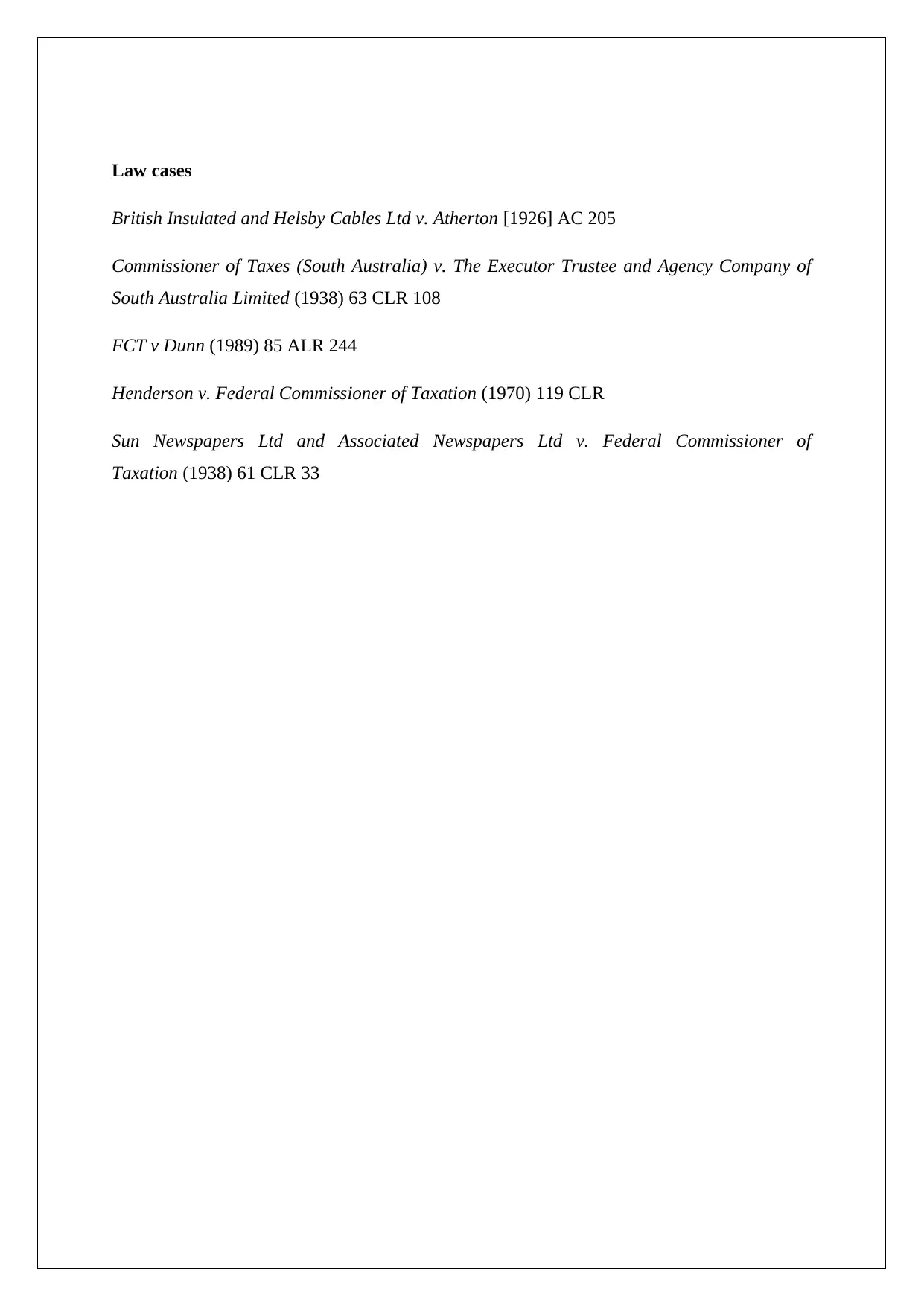
Law cases
British Insulated and Helsby Cables Ltd v. Atherton [1926] AC 205
Commissioner of Taxes (South Australia) v. The Executor Trustee and Agency Company of
South Australia Limited (1938) 63 CLR 108
FCT v Dunn (1989) 85 ALR 244
Henderson v. Federal Commissioner of Taxation (1970) 119 CLR
Sun Newspapers Ltd and Associated Newspapers Ltd v. Federal Commissioner of
Taxation (1938) 61 CLR 33
British Insulated and Helsby Cables Ltd v. Atherton [1926] AC 205
Commissioner of Taxes (South Australia) v. The Executor Trustee and Agency Company of
South Australia Limited (1938) 63 CLR 108
FCT v Dunn (1989) 85 ALR 244
Henderson v. Federal Commissioner of Taxation (1970) 119 CLR
Sun Newspapers Ltd and Associated Newspapers Ltd v. Federal Commissioner of
Taxation (1938) 61 CLR 33
1 out of 9
Related Documents
Your All-in-One AI-Powered Toolkit for Academic Success.
+13062052269
info@desklib.com
Available 24*7 on WhatsApp / Email
![[object Object]](/_next/static/media/star-bottom.7253800d.svg)
Unlock your academic potential
© 2024 | Zucol Services PVT LTD | All rights reserved.





